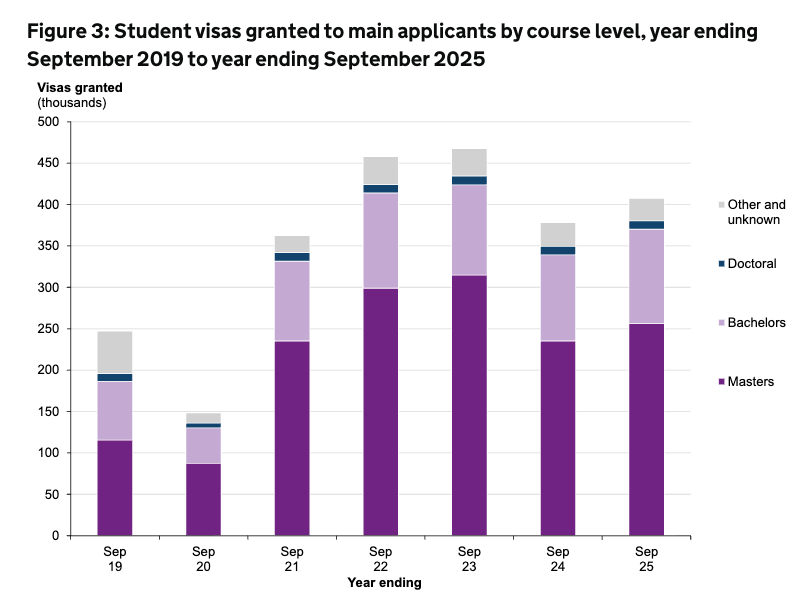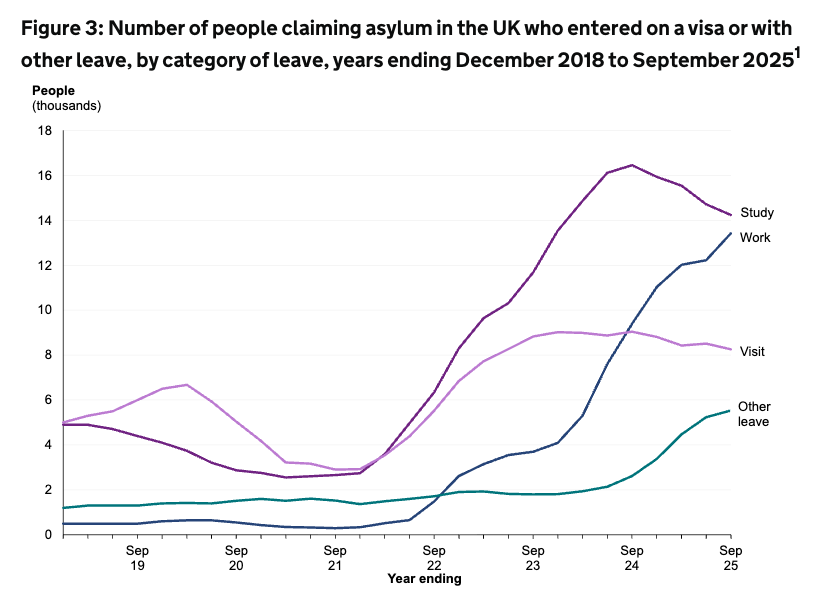All the higher education-relevant Home Office stats for Q3 2025
Michael Salmon is News Editor at Wonkhe
Tags
It’s been a busy week – here’s a quick runthrough everything the Home Office has published today.
Student visa awards
Overall: There were 419,558 main applicant student visa grants in the year to September 2025. Compared to the last time we looked, we now have the figures for the key months of July, August and September. This total is seven per cent more than in the year to September 2024 which, given that the impact of the dependant ban was already affecting applicant behaviour by late 2023, makes for a fairly good year-on-year comparison and demonstrates the slight rebound in international recruitment (at sector-level) over the last year.
It feels like we make this point every time, but despite recent dips international student visa numbers are still far higher than they were before the pandemic and the introduction of the graduate route. Dependants are of course well below their level pre-PGT ban, but in 2025 Q3 there were still 8,854 dependant visas issued.
By level: The useful “sponsored study entry clearance visas by course level” tables available on this page show the split in issued visas by course level, and can also be broken down by nationality. In headline terms, we’ve seen undergraduate and doctoral level visa awards remain pretty consistent, with the bigger swings at master’s level, as this Home Office graph shows:

By nationality: In the latest yearly figures Indian main applicants have taken top spot again, with a widely remarked on dip in visa holders from China. Nepal is now the fifth most important sending country, with an 89 per cent rise to 20,572 grants.
By refusal: With new BCA rules looming, it’s always worth having a look at refusal rates by nationality. For example, in Q3 there were 50,360 study visas issued to Indian nationals, and 1,087 refusals. For Pakistan there were 14,384 issued, 1,132 refused; for Nigeria, 15,218 issued, 835 refused; for Bangladesh, 5,786 issued, 544 refused. I wrote more about the difficulties the new UKVI rules will cause providers who recruit heavily from certain countries here, but it’s clear the challenge is not going away any time soon, even if implementation is not going to be as draconian as once painted.
By provider type: Well there’s no breakdown by provider type in the Home Office data any more, nor data on CAS issuances – this section of the release was discontinued. But you may have spotted that last week’s Office for Students financial sustainability release had some pretty in-depth Home Office data on CAS broken down in some depth across the English (we assume) landscape.

It would be nice to have more of this sort of detail in the regular Home Office release, but it’s much more useful for it to be properly categorised by OfS rather than the blunt Russell Group vs non-Russell Group split that the Home Office used to provide. A spreadsheet with actual numbers would have been appreciated though.
Graduate route
The year ending September 2025 saw 237,452 extensions onto the graduate route, around 10 per cent up from y/e September 2024 (215,877). This is another noticeable rise, but as the Home Office write-up puts it, a “much smaller increase” than the 67 per cent jump between 2023 and 2024 (in y/e September 2023 there were 129,175 extensions).
The number of students moving onto the graduate route necessarily follows behind the peaks in student numbers, so we should expect this number to plateau or even slightly decrease in further rounds. The question still remains whether, longer-term, 200,000+ students moving onto the graduate route each year is a figure that the Home Office can live with.
Global talent route
The global talent visa has been ticking along at around 1,500 to 2,000 issuances each quarter since mid-2022 (including dependants – without, it’s tended to be 800-1000). The government has indicated that it will further incentivise its use, but it isn’t currently capped so until we see the details it’s unclear to what extent these will just be tweaks. There were 1,199 issued to main applicants in Q3 2025, the highest on record, but only by a smidgen.
Universities increasingly using it – this fascinating case study from the University of Exeter (via CaSE) shows that it’s become the university’s preferred route for employing international staff, as the skilled worker visa takes longer, especially with ATAS processing, and it’s preferred by applicants.
Here are the nationalities of those issued global talent visas (main applicants) so far in 2025:
| China | 471 |
| USA | 357 |
| India | 352 |
| Russia | 186 |
| Nigeria | 126 |
| Italy | 121 |
| Germany | 119 |
| Iran | 118 |
| France | 97 |
| Turkey | 86 |
Asylum
In Q3 there were 3,226 asylum claims from people who had previously held a student visa. This is lower than any quarter in 2024, but the figure of 10,060 claims so far this year means that 2025 is still likely to record the second highest total. The Home Office’s graph shows the medium-term trend.

Elsewhere at UKVI
There’s a relatively new “migration transparency” dumping ground page with additional information from within the depths of UK Visas and Immigration. It’s largely pretty niche, but you can see things like what proportion of student and graduate route applicants have been coughing up for priority and super priority applications (in the “visa, status and immigration data” spreadsheet).
A separate “sponsorship transparency data” release is where you’ll find information on new student sponsorship applications, how long they took, what proportion were refused, and what action UKVI has taken for non-compliance with its conditions. In 2025 Q3, for example, nine organisations sponsoring students were handed “intention to revoke” notices, and four had their licences revoked.
This tells us nothing about enforcement action against higher education institutions, however, who make up only a small slice of student sponsors (alongside private schools, independent training providers, and overseas high schools – the full list is here, in the mysterious spreadsheet where UKVI occasionally notes that a sponsor is subject to an immigration compliance action plan. Five UK higher education institutions currently have that honour, with no further information given).

